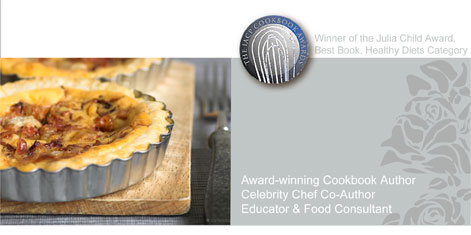 |

|

. |
If you have these items on
hand and one or two fresh
vegetables, you’ll always be
able to make a healthy and
delicious meal.
CHECK
CUPBOARDS FOR:
Whole peppercorns
Extra virgin olive oil
Canola oil
Red wine vinegar
White wine vinegar
Sherry vinegar
Balsamic vinegar
Soy sauce
Canned chicken broth/stock
Bottled salsa
Rice
Couscous
Flour
Sugar
Prepared marinara sauce
Pasta: several shapes & sizes
Salt: sea salt and kosher
Canned tomatoes
(28 ounce &14-ounce sizes,
whole or chopped)
Water-packed tuna (with salt)
Canned beans
(chick peas, white beans, black
beans); rinse before using
Canned or bottled roasted
peppers:
for salads, bruschetta, pasta
Dried beans
especially quick cooking types
like lentils
Imported olives
(refrigerate after opening)
CHECK
VEGETABLE BINS FOR:
Onions
Garlic
Potatoes
Lemons
CHECK
REFRIGERATOR FOR:
Feta cheese (optional)
Fresh ginger
Capers (optional)
Eggs, preferably free range
Low-fat or nonfat plain yogurt
Imported Parmesan cheese
(a block, and if you have a
reliable source, grated, but not
the stuff in the green can!)
CHECK
FREEZER FOR:
Frozen peas
Whole grain bread
Corn tortillas
Chicken Breasts
boneless, skinless
Chicken stock
homemade if possible
|
|
• INCLUDE FRESH, SEASONAL PRODUCE IN EVERY MEAL.• |
Vegetables and fruits are the key to healthy cooking. Today's supermarkets, whole
foods stores, and farmers' markets are stocked with an impressive array of produce, and if that's the focus of your diet, shopping becomes very exciting. What's in season? What looks good?
|
|
•SHOP FOR PRODUCE AT FARMERS’ MARKETS• |
Worlds of flavor will open up to you as you discover the flavor of a really sweet pea,
a vine-ripened tomato, a peach harvested less than a day ago. You'll also become
aware of the seasonality of things; it's a thrill when the first cherries come in, or the
Blue-Lake beans appear in my Los Angeles markets in the spring, sweet corn in the
summer. I am not saying that an entire meal must be based on vegetables, all of which require preparation. But one fresh vegetable added to a pasta will greatly increase the nutritional value -- and the satisfaction -- of your meal.
|
|
•FOCUS ON ANIMAL PROTEIN THAT IS LOW IN SATURATED FAT• |
This means fish, poultry, and some cuts of pork. Beef and lamb are high-fat meats,
so eat these meats less often, and look for grass-fed, humanely raised animals when
you do shop for meat. Remove the skin from poultry, and if possible buy free-range
chicken, as it is less fatty than battery chicken and has not been shot up with
hormones and antibiotics.
|
|
•USE LOW-FAT (1%) OR NONFAT DAIRY PRODUCTS•
(MILK, COTTAGE CHEESE, YOGURT)
•USE HIGH-FLAVOR CHEESES IN MODERATION •
(PARMESAN, GRUYÈRE, FETA, AND GOAT CHEESE)
|
I do not recommend using nonfat cheese. This is manufactured stuff, and has a rubbery texture and no flavor to speak of.
|
|
•USE MONO-UNSATURATED OILS LIKE EXTRA VIRGIN OLIVE OIL AND CANOLA OIL•
Use them moderately: you only need a tablespoon of oil to sauté an onion. |
|
•FOCUS ON ONE-DISH MEALS• |
It can be a main dish soup or salad, a stew, tacos, a stir-fry or a pasta, as long as
there is variety and at least one fresh ingredient. I usually complement hot one-dish meals with a green salad, which is easily thrown together and gives me the crunch of lettuce or other raw vegetables that I crave at almost every meal.
|
|
• DO NOT UNDER-SEASON• |
One of the reasons that light cooking sometimes has a reputation of being bland
cooking is that too often it is bland. Do not be afraid of salt. Salt is essential, both for
bringing out the flavors of foods and for bringing flavors into balance. Garlic, pepper,
fresh and dried herbs and spices, lemon juice and peel, are all important when it
comes to seasoning.
|
|
• KEEP YOUR PANTRY AND REFRIGERATOR STOCKED• |
This way good, healthy meals can be quickly thrown together.
|
|
•SIT DOWN TO A MEAL WITH YOUR FAMILY OR BY YOURSELF AT LEAST ONCE A DAY• |
| |
 |
|



